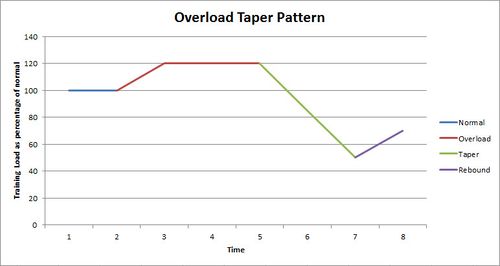Three Phase Taper (AKA Overload Taper)
A three phase taper, sometimes called an overload taper, is a technique that has been shown to have greater benefits than the traditional single phase taper. There is less experience with the three phase taper, so this should be considered a higher risk approach for experienced athletes.
1 The Three Phases
This style of taper is constructed from three phases; overload, reduction, and rebound.
1.1 Overload
The overload phase consists of an increased training load, typically 20% more. This period has to be kept fairly short to prevent overtraining, typically 1-4 weeks. The level of overload will depend on how intense the normal training load is. A runner who is already training near their maximum capability would want to overload for a shorter time than a runner who has more training headroom. Many training plans tend to have the peak training load towards the end of the program, but often the peak is a little too early and too minor to be considered an overload period. (See A Comparison of Marathon Training Plans.)
1.2 Reduction
This phase is the same as the traditional taper, with reduced training load. Typically a greater reduction in training load for a shorter period is used with a three phase taper than with a traditional single phase taper.
1.3 Rebound
The rebound is a short increase in training load, just before competition. This approach was developed from the observation that some athletes in multiday competitions such as track races have their performance improve as the heats progress. How much the training load should be increased is not well defined, but the general idea is to focus on increased intensity with a moderate uptick in volume. The rebound should be in the last few days before competition.
